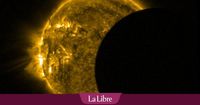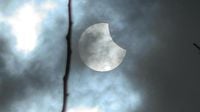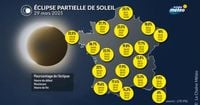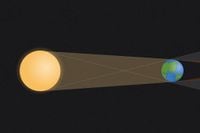On Saturday, March 29, 2025, a partial solar eclipse captivated observers across France and Belgium, drawing attention to the skies as the moon partially obscured the sun. In France, the phenomenon was most pronounced in Finistère, where 32.5% of the sun's disk was covered in Brest. Meanwhile, in Corsica-du-sud, only 6% of the sun was obscured. The event began at 11:08 AM in Paris, peaked at 12:01 PM, and concluded at 12:56 PM, with 23.5% of the sun masked during the peak.
In Belgium, the eclipse started at 11:14 AM, reached its maximum coverage of 38% at 12:07 PM in the west, and ended at 1:01 PM. Those in the southeastern region experienced slightly less coverage, with only 31% of the sun obscured. The last similar event in Belgium occurred in October 2022, and the next partial solar eclipse is scheduled for August 12, 2026, where up to 90% of the sun may be covered.
As the moon passed between the Earth and the sun, it created a spectacular sight, but it also posed dangers to observers. Experts warned against looking directly at the sun without proper eye protection. Traditional sunglasses do not provide sufficient protection, and viewers were advised to use eclipse glasses that meet the ISO 12312-2 safety standard. Those using telescopes or binoculars needed special solar filters to safely view the event.
Meteorological conditions on the day of the eclipse varied across regions. In France, the northwest enjoyed clear skies, providing excellent viewing opportunities in cities like Nantes, Rennes, Rouen, and Paris. However, the eastern parts of the country faced cloud cover, particularly in cities like Strasbourg, Besançon, and Lyon, which hindered visibility. In Belgium, while the eclipse was noted as a significant event, the ambient light remained largely unchanged due to the partial nature of the eclipse.
Philippe Mollet from the Mira Observatory in Belgium remarked on the rarity of witnessing a solar eclipse three years in a row, emphasizing the unique opportunity for skywatchers. He noted, "It is very exceptional that there is a solar eclipse in Belgium three years in a row." The maximum coverage of the eclipse was observed in northern Canada, where about 94% of the sun was obscured, showcasing the varying experiences of this celestial event across different locations.
The last total solar eclipse visible in France occurred on August 11, 1999, and the next one is not expected until September 3, 2081. This upcoming total eclipse will be visible in the southwest of France, creating anticipation among astronomy enthusiasts.
As the world gears up for future eclipses, awareness of safety measures remains crucial. The 2026 and 2027 eclipses promise to be particularly noteworthy, with the former expected to cover 90% of the sun and the latter anticipated to provide a half-covered view. These events will be total in certain parts of the world, including northern Spain and northern Africa, potentially influencing travel plans for eclipse chasers.
For those unable to witness the March 29 eclipse, the next opportunity will be on August 12, 2026. As the moon continues its dance with the sun, these celestial events remind us of the beauty and wonder of our universe, urging us to look up while taking the necessary precautions to protect our eyes.
In conclusion, the partial solar eclipse on March 29, 2025, served as a reminder of the delicate alignment of celestial bodies and the importance of safe viewing practices. As we await future eclipses, the excitement for these astronomical events continues to grow.







